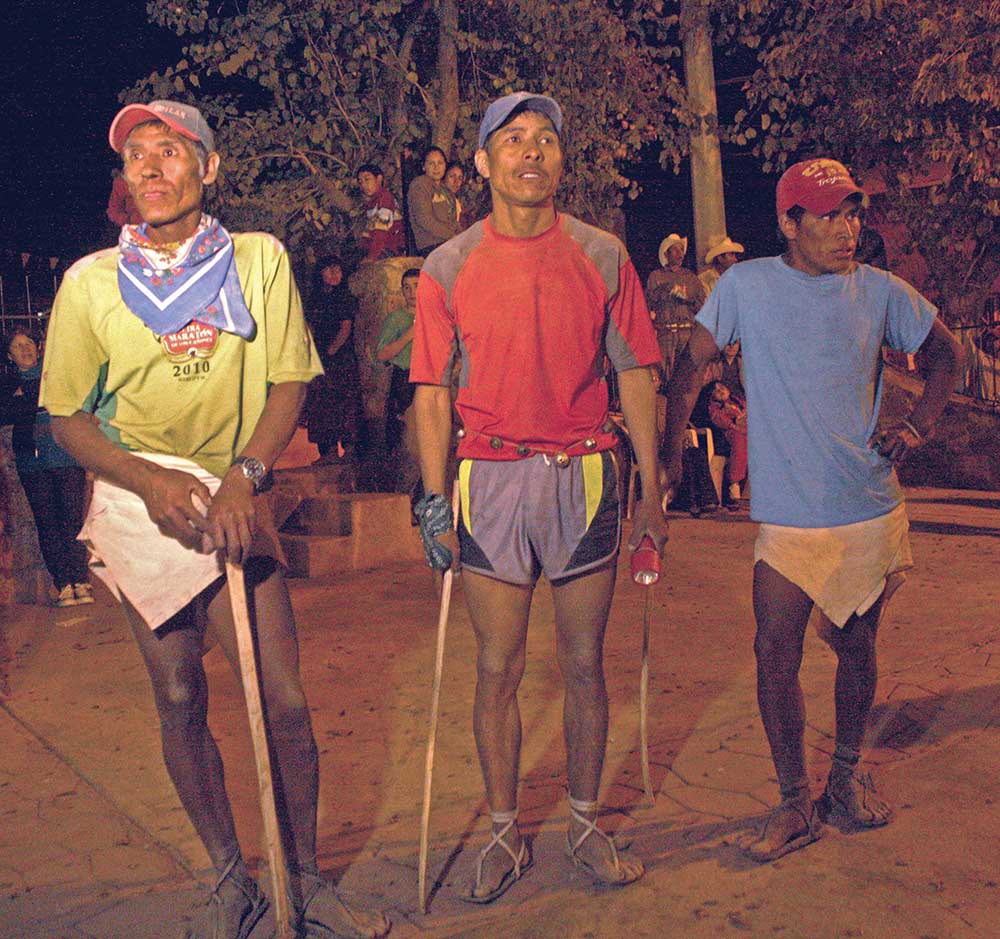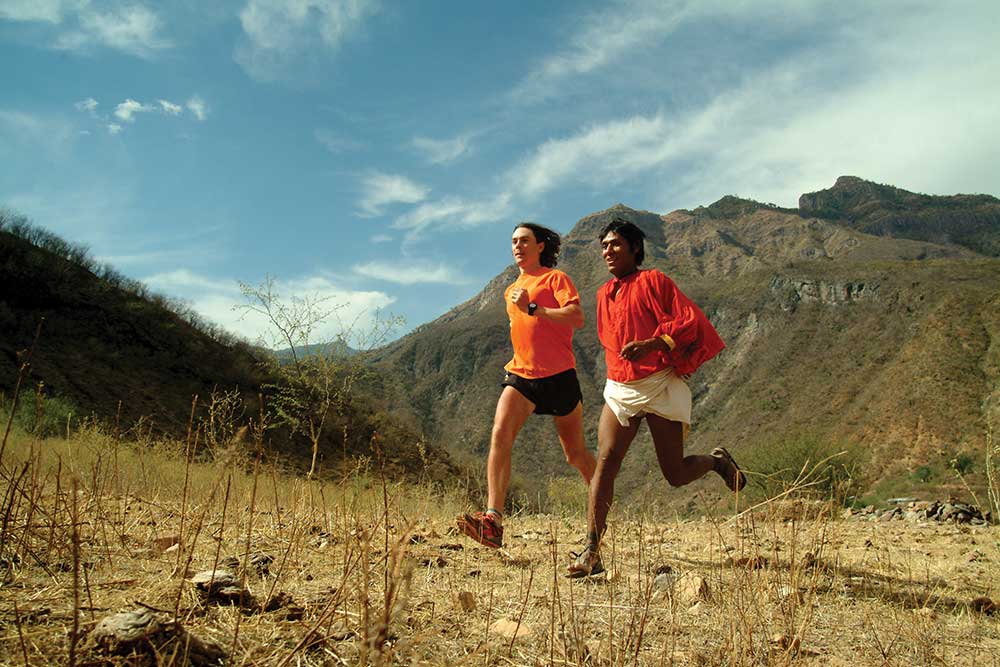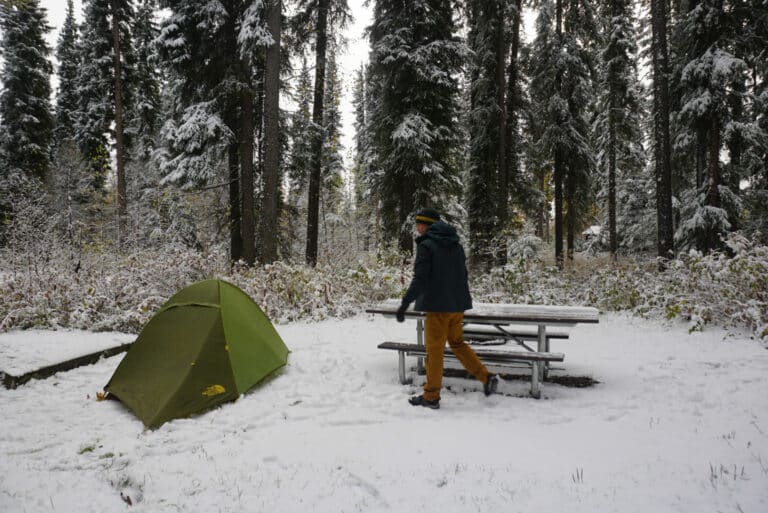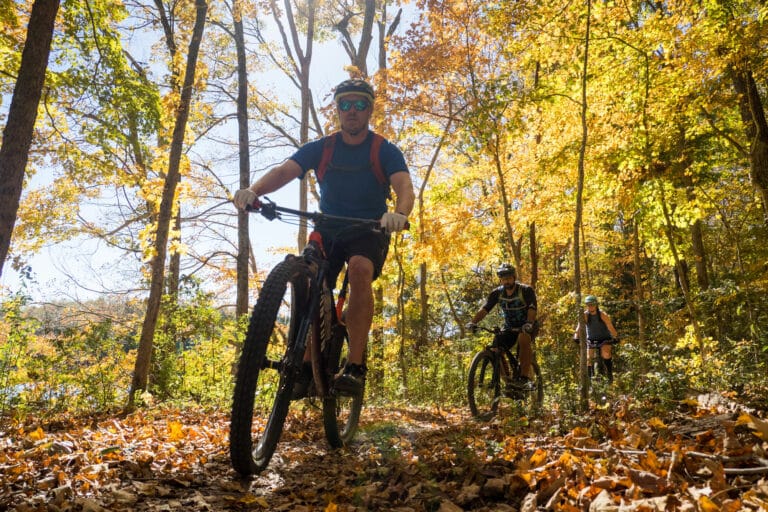Photo: Scott Jurek and Arnulfo Quimare run side-by-side through the Copper Canyons of Mexico. Photo by Luis Escobar.
What I Learned from the Tarahumara’s Most Famous Runner
I first met Tarahumara runner Arnulfo Quimare in 2005 right after he crossed the finish line in the Ultramaratón Caballo Branco (80K) in Urique, Mexico. He had just won first place by outlasting American runner Scott Jurek. We sat on a bench outside Mama Tita’s restaurant in the center of town right after the race. He appeared bien tranquilo in body and soul. He hocked up a few spitballs and sipped water; a sheen of white dust powdered his hair and face, otherwise he seemed little worse for the wear.
For over 7 hours he had run up and down river bluffs on dirt-packed roads; had skirted the edges of towering cliffs and had descended on rock-strewn trails where one misstep means serious injury, possibly death. In the second half of the race, the sun seethed into the canyon like the glow of a branding iron.
I stared at his feet clad in huaraches (sandals), rivulets of cracks in thick callous.
“Aren’t you exhausted?” I begged.
“Only a little bit, mainly in my thighs,” he shrugged, patting his legs. “You know this is a short race for Tarahumara.”
“Short race? But you just ran 80 kilometers through one of the deepest canyons in the world!”
“Sí, no?” He cackled, his deep-brown eyes sparkling.
Arnulfo shocked the international, ultra community by defeating Jurek in Urique, the story made legend by the bestselling book Born to Run by Chris McDougall. At the time of the race, Jurek had established himself as one of the premier ultra runners in the world by winning numerous prestigious races, setting records in most of them including Western States (7 times), the Spartathlon in Greece, a 153-mile race from Athens to Sparta (3), the Hard Rock Hundred Mile Endurance Run (2) and the Badwater Ultramarathon (2).
Conversely, Arnulfo had only run (and won) two western-style ultra marathons in his life at the Ultramaraton de Los Canyones in Guachochi. He was more accustomed to racing while flinging a wooden ball with his foot as he ran in rarajipari, the ancient, traditional race of Tarahumara, that often covers distances of 100-150 kilometers. He had reigned as the champion of rarajipari in the Sierra Madre since he had turned 18, but western-style ultra marathons were totally new concepts.
When Jurek arrived in Urique he had followed an intense training regimen and practiced an extreme vegan diet. He had worked with professional trainers and medical specialists. He toed the starting line wearing the best running shoes money could buy and carried a pouch around his waist with power bars and a Camelbak water container. Like all the foreigners, he warmed up extensively before the race.
Arnulfo wore simple sandals made of tire rubber soles, tied to his ankles with leather straps, a white loincloth and a colorful, blousy top. He leaned against the wall of a building awaiting the call for the start of the race, joking and laughing with his friends. He never warmed up. He had not spent any time preparing for the race, no formal training whatsoever, and had lived on a simple diet of beans, corn and chiles that he had grown in his fields.
The reigning world champion ultra marathoner ventured into the Sierra Madre to test his mettle against the king of the indigenous runners. Jurek later told me he was shocked that in the end he could not catch Arnulfo.
How is it possible that Tarahumara like Arnulfo, without any form of standard training regimen, can compete with world class distance runners, run 100 miles while flinging a wooden ball with his foot, even run deer to exhaustion? How can they stay so conditioned that they can walk 12 hours from the bottom of one canyon, cross the mountaintops and drop into another canyon to compete against well-trained athletes, and the next day win the top prizes by outrunning everyone?
A few years later, I had the opportunity to ask Arnulfo these questions.
We stood beside a fire at his home in Soriachique at the top of the mountains above Urique on a cold, windy morning in January. I was dressed in blue jeans, thermal underwear, sweater and a winter coat; still I huddled close to the fire to stave off the shivers. Arnulfo wore only a light jacket and a baseball cap, his legs beneath his loincloth skirt and his feet in huaraches bare to the wintry air. Silent and reverent we fixed our gaze on the tip of the sun peering into the canyon, casting waves of sublime colors across the rocky peaks.
“Arnulfo, what is it that makes Tarahumara such extraordinary runners?”
“Quien sabe? (Who knows?) Just because we are Tarahumara, I guess.” He grinned.
“Of course, but why are you so motivated to run rarajipari races and compete in ultra marathons like the ones in Urique, Guachochi and other parts of Mexico?”
He nudged a log to the center of the fire with the tip of his toe and stared at the flames like a diviner searching for the truest answer.
“I love to run and my ability to run is God’s gift,” he mused. “And running always helps me remember who I am as a human.” He shook his fist to enunciate the surety of his claims.
“When we run and dance we give thanks to God.” He hesitated while he tossed a handful of wood chips into the fire pit.
“And we win prize money!” He added with a big grin.
I stared at his sandals that he had made from a slither of tire rubber and white leather straps that he had looped between his toes and had wrapped around his ankles.

“Why don’t you run in shoes like the gringos?”
“Because with my huaraches I can better feel the ground and the movement of the rocks with my feet.”
I understood. I had walked thousands of miles on the same canyon trails as Arnulfo and on paths through the North Carolina mountains wearing sandals. I wanted my bare feet as close to direct contact with earth and rocks as possible. The canyon trails demand that one walk lightly over the rocky paths with agility and flexibility. In some places the paths are smooth, hard packed dirt, a joy to glide across but the majority of the trails are filled with unstable rocks. Without constant mindfulness the trails can be treacherous.
“Do you ever run barefoot as some outsiders have claimed?”
“Claro que no,” he laughed like he was unsure of my gringo sanity. His land is studded with a million thorns and sharp-edged stones, with scarred feet, gnarled toes and cracked nails bearing witness.
“Would you like to run, or even live in another country like the United States or in a city like Chihuahua so you would have more opportunity to compete in races?
“No.”
“Why?”
“Too many people in the city. Too much noise and the air smells bad.” He scanned the few simple homes spread along the perimeter of the canyon’s rim and the rolling fields dotted with cows and goats. “I prefer to stay here in the canyons and live a normal life.”
I asked him one more important question. I wanted to settle once and for all the running habits of Tarahumara athletes and correct the common misperceptions of outsiders.
“Do you train for the races like the international and national runners?”
“No.”
“Not at all?”
“Solamente corro en carreras…o cuando me asusto,” he cackled. He said he only runs when he competes in races, or when he’s scared.
“You don’t prepare for the races at all?” I wanted to make sure I had heard him correctly.
“No. Nada.” Period.
In his inimitable manner, Arnulfo exploded the popular myth that Tarahumara run all the time. They do run, walk, and trek everywhere they go, but they train for races very little. They don’t have the caloric luxuries of training hard year-round; most of their running is to get somewhere. Yet, when Arnulfo and other Tarahumara do race, they run a very long way and with an deeply rooted passion, even reverence, for the joy of being in motion.








